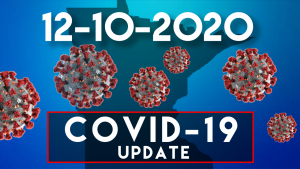12-10 COVID-19 Update: Symptoms ‘Can Go on for Weeks or Months’
Minnesota Department of Health to Discuss Long-Term Effects of COVID-19

Also see: 12-9 Minnesota COVID-19 Update: 82 New Deaths, 4,589 New Cases
The Minnesota Department of Health held a conference call Thursday to brief members of the media on the latest public health information regarding COVID-19.
MDH Commissioner Jan Malcolm:
- Globally, 69.1 million cases since start of pandemic; 1.57 million deaths
- In U.S., 15.5 million cases since pandemic began (up 219,000 over previous day); 290,000 deaths (up 3,112)
- 109,000 Americans in the hospital currently, highest number so far.
- In Minnesota, 367,218 total confirmed cases (up 3,523 on testing volume of 41,500)
- Of the 367,218 cases, 324,304 (88%) are no longer considered infectious
- In Minnesota, 4,198 total deaths (up 89)
- Of the 89 newly reported deaths, 56 occurred at long-term care/assisted living facilities
- 7 of the deaths below age 60, including two in their 20s
- 1,542 currently hospitalized in Minnesota, including 352 in intensive care units
- The number of people in intensive care has dropped since Dec. 1 when 401 patients were in Minnesota ICUs
MDH Medical Director Dr. Ruth Lynfield:
- Many people who are infected with COVID-19 do NOT have symptoms, can pass it along to others who may develop symptoms.
- About 50% of transmission can occur in people who are asymptomatic
- “We are learning more and more that in some situations COVID-19 is not just an acute illness,” said Lynfield. “They can develop symptoms that can go on for weeks or months.”
- For so-called “long-haulers,” those whose symptoms linger, MDH still learning how common these symptoms may be and who is most likely to get them, said Lynfield
- Symptoms may include fatigue, shortness of breath, cough, joint pain, chest pain, difficulty thinking and concentrating (known as “brain fog”), memory difficulties, change in mood, development of anxiety, muscle pain, headache, intermittent fever, a fast beating or pounding heart
- “People who have a mild illness can develop symptoms that last for months.”
- MDH officials believe MIS-C (multisystem inflammatory syndrome in children) is related to COVID-19.
- This is very rare, said Lynfield. Still learning about this syndrom
- Children get fever and other various symptoms (sometimes fever develops before other symptoms).
- Other symptoms include: abdominal pain, decreased appetite, vomiting, diarrhea, rash, redness in eyes, swelling of hands and feet, fatigue, body aches often develop.
- All Minnesota children who developed MIS-C were hospitalized (more than half required intensive care).
- Nearly 75% of 1,288 MIS-C cases nationwide (as of Dec. 4) have been in racial or ethnic minorities. 23 children have died nationwide of MIS-C.
- MIS-A (multisystem inflammatory syndrome in adults) has developed in younger adults. This is even more rare than MIS-A.
- At least 70 cases reported nationally, 2 cases in Minnesota
- “This is not just a problem for the elderly or fellow Minnesotans who have medical conditions,” said Lynfield.
- “Until we have a safe and effective vaccines, we really need to do everything we can to stop the transmission between fellow Minnesotans,” she said. “We have to do our best to get our numbers down. We know this is hard. This is really, really hard. This pandemic has been going on for a long time. It is taking a big toll in so many areas of our lives. And it is hard for us as health officials too. But we have to hang in there and we have to do the best we can.”
Q&A Session and Notes:
- On people with long-term symptoms: Lynfield says MDH does not have data yet on how many Minnesotans develop long-term issues. CDC also working on this data. Sees large variations of percentages in medical research, said Lynfield. Hesitant to offer a percentage.
- On people in their 20s who died, Malcolm said it’s “definitely unusual statistically.” Lynfield says generally younger people who die have variety of health conditions, such as obesity, diabetes, hypertension.
- “We all need to remember these conditions are very common in our community,” said Lynfield.
- Advice for getting tested: Lynfield says symptoms do overlap with other illnesses. Recommends “if you have a new symptom, you should be tested.” Same goes for known exposure. Get tested 5-7 days after this exposure. “We all need to have a very low threshold,” said Lynfield because of how it’s so easily spread to others.
- Lynfield: We now have very good data that people who have mild symptoms are not contagious after 10 days.
- People who do have severe disease (hospitalized) or people who are immunocompromised, MDH recommends they be isolated for 20 days after onset of acute symptoms, unless they have two negative tests before the 20 days.
Brooklyn Center | Brooklyn Park | Champlin | Crystal | Golden Valley | Maple Grove | New Hope | Osseo | Plymouth | Robbinsdale | Rogers | Twin Cities | Wayzata



